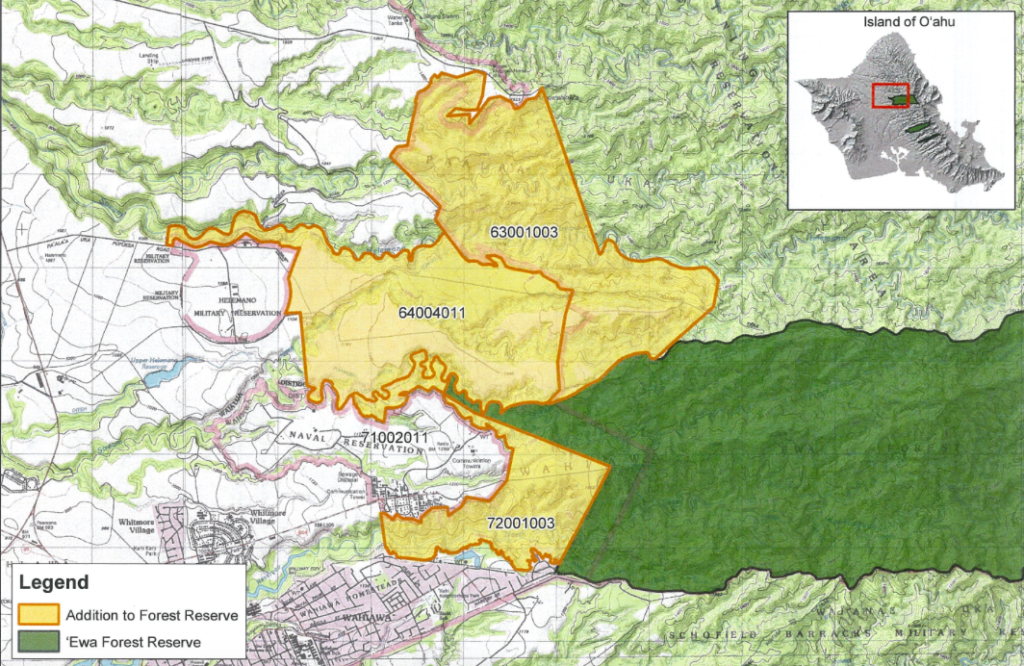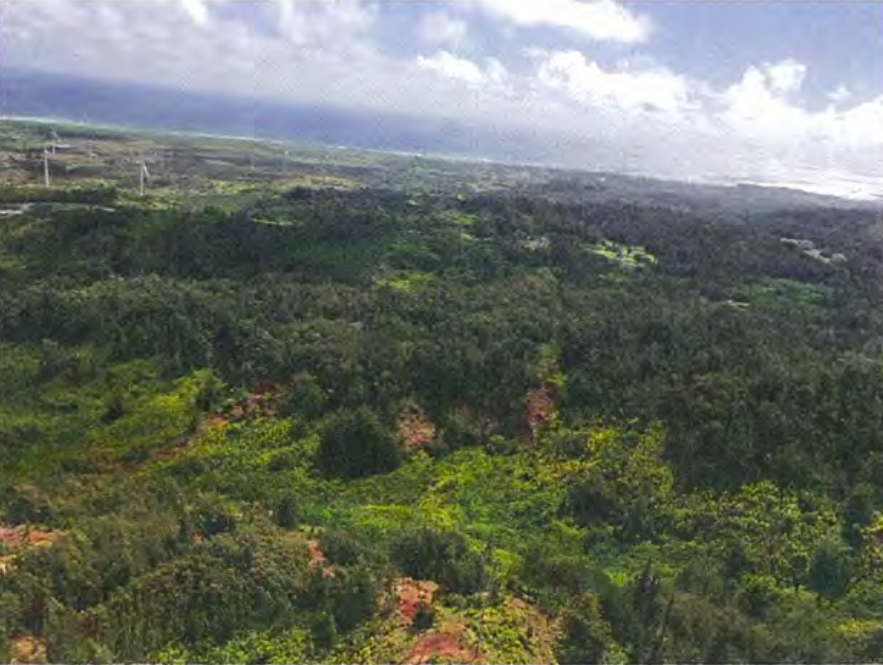
On October 25, the state Board of Land and Natural Resources unanimously approved the acquisition of 3,716 acres of native forest owned by Dole Food Company on O‘ahu’s North Shore for $3.716 million and authorized public hearings to add those lands to the Pupukea-Paumalu forest reserve.
A report to the Land Board by the Department of Land and Natural Resources’ Division of Forestry and Wildlife (DOFAW) noted that the acquisition, once complete, will ensure that the entire ahupua‘a of Waimea is preserved. In 2006, the Office of Hawaiian Affairs purchased the lower portion of Waimea Valley to protect it from development. The DOFAW purchase would protect the summit area.
The latter acquisition received several letters of support from a range of entities, including the U.S. Fish and Wildlife Service, Malama Pupukea-Waimea, and the Pacific Islands Climate Change Cooperative.
Dole’s liquidation of its agricultural lands on O‘ahu over the past several years has provided the state with a huge opportunity to preserve thousands of acres for agriculture and conservation. But some of those purchases have come with a few surprises.
During DOFAW administrator David Smith’s presentation to the board on the Waimea acquisition, he mentioned that there was an outstanding issue with the state’s purchase last year of 2,881 acres of Dole land at Helemano. He described a boundary dispute, with discussion among the involved parties going “back and forth,” but board members did not question him about it.
According to his written report to the board, a 58.54-acre parcel that was part of the $15,163,800 million purchase wasn’t Dole’s to sell. It actually already belonged to the state.
A warranty deed for the sale of the four parcels included in the deal was recorded in the Bureau of Conveyances in October 2018. After a public hearing a couple of months later, the Land Board voted in May to add the Helemano lands to the ‘Ewa forest reserve.
In preparing maps for the executive order designating the lands as a forest reserve, the state surveyor discovered a discrepancy in the ownership of the 58.54-acre parcel, Smith’s report stated. “The parcel is not a lot of record, but rather a remainder parcel created from the boundaries of surrounding parcels. It was discovered that the parcel was never actually conveyed by the state and had remained under government ownership. The Department, along with the Attorney General, is currently working with Dole to resolve this matter,” it continued.
It’s unclear how the title discrepancy was only discovered after the sale. A September 2018 DOFAW report to the Land Board on the acquisition of the Helemano lands states that the division obtained title reports for the parcels “for the state’s review and approval.”
“A preliminary boundary review was conducted prior to the purchase indicating that Dole owned all four parcels of land and the boundaries of the land were accurately represented in the purchase documents. However, an irregularity was discovered after the purchase,” is the only explanation DLNR staff offered in an email Environment Hawai‘i.
Most of the money for the purchase of what DOFAW calls the Helemano Wilderness Area came from federal sources, but $2.75 million came from the Kawailoa wind farm as mitigation for take of endangered bats and a little more than $1.5 million came from the state’s Land Conservation Fund.
The parcels included lands in both the Conservation and Agricultural land use districts. Conservation lands are generally appraised at a lower value than agricultural lands, but according to property tax records, the 58.54-acre parcel had an assessed value of only $100 since at least 2001. However, in the 2017 appraisal for the purchase of all four parcels, the two parcels with the potential for agricultural use and speculative investment — the 58.540-acre parcel and a 1,247.7-acre parcel — were assigned a combined fair market value of $14,890,000, which works out to $11,399 per acre.
The actual purchase price was more than a million dollars lower than the appraised price. And according to DLNR staff, “Because the purchase was a ‘bulk’ sale of all four parcels at once, the valuation was spread evenly over each acre.” Given that, the state paid about $308,000 for the 58.54- acre parcel.
“Given the significant public interest in acquiring the Waimea Native Forest, the Board is requested to approve the current acquisition despite the outstanding issue regarding the Helemano Wilderness Area parcel. Completing the present acquisition will not serve to waive any rights or avenues to relief that the State may have in the Helemano matter. Furthermore, the Department and the Attorney General will continue to seek resolution on that matter independently, including pursuing alternatives for relief as appropriate,” the report stated.
In light of the problem with the Helemano purchase, DOFAW recommended that the Land Board require Dole to convey the Waimea lands to the state via a warranty deed.

“Spanning 600 to 2,600 feet in elevation, and containing the headwaters of Kamananui and ʻElehāhā Streams, which flow to Waimea Bay, the Waimea Native Forest is an important recharge area and a high priority watershed for both DOFAW and the Honolulu Board of Water Supply,” the Trust for Public Land stated in its letter of support for the state’s purchase of Dole lands in Waimea.
Daniel Nellis, Dole Food Company’s general manager, testified that his company had been working with the state for several years on the Waimea transaction. “I hope it goes through,” he said.
In its email to Environment Hawai‘i, the DLNR’s only comment on whether Dole agreed with the state’s ownership assessment of the 58-acre parcel was, “We are in discussions with Dole regarding this issue.” It added that the issues with the parcel do not in any way threaten the Helemano purchase and have not complicated negotiations regarding the Waimea lands. Staff only brought the issue to the board’s attention in the interest of transparency, the agency stated.
Lead Remediation
In September 2018, when the Land Board approved the purchase of the Helemano lands, a heated discussion ensued over who was going to take care of contamination that had been discovered on one of the larger parcels.
The contamination was the result of a former Dole tenant allowing about an acre to be used as a firing range. Soil testing revealed significant lead contamination and elevated antimony levels.
“Dole was unwilling to remediate the site prior to closing the acquisition, so TPL” — the Trust for Public Land, which brokered the purchase — “assumed responsibility for remediating the site post-closing and obtaining a determination of No Further Action from the Hawai‘i Department of Health,” Smith’s report stated, adding that the DOH provided a No Further Action determination on August 2.
— Teresa Dawson

Leave a Reply